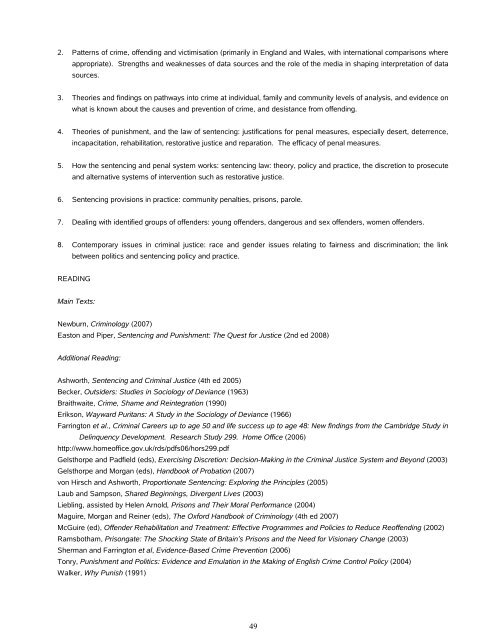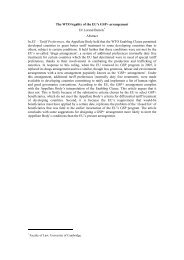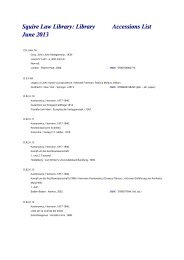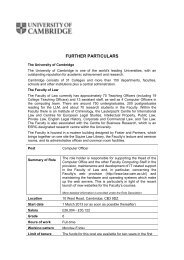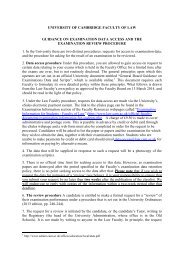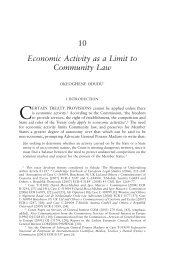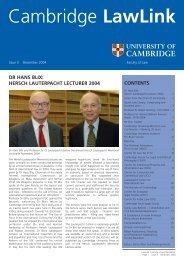Contents - Faculty of Law - University of Cambridge
Contents - Faculty of Law - University of Cambridge
Contents - Faculty of Law - University of Cambridge
Create successful ePaper yourself
Turn your PDF publications into a flip-book with our unique Google optimized e-Paper software.
2. Patterns <strong>of</strong> crime, <strong>of</strong>fending and victimisation (primarily in England and Wales, with international comparisons whereappropriate). Strengths and weaknesses <strong>of</strong> data sources and the role <strong>of</strong> the media in shaping interpretation <strong>of</strong> datasources.3. Theories and findings on pathways into crime at individual, family and community levels <strong>of</strong> analysis, and evidence onwhat is known about the causes and prevention <strong>of</strong> crime, and desistance from <strong>of</strong>fending.4. Theories <strong>of</strong> punishment, and the law <strong>of</strong> sentencing: justifications for penal measures, especially desert, deterrence,incapacitation, rehabilitation, restorative justice and reparation. The efficacy <strong>of</strong> penal measures.5. How the sentencing and penal system works: sentencing law: theory, policy and practice, the discretion to prosecuteand alternative systems <strong>of</strong> intervention such as restorative justice.6. Sentencing provisions in practice: community penalties, prisons, parole.7. Dealing with identified groups <strong>of</strong> <strong>of</strong>fenders: young <strong>of</strong>fenders, dangerous and sex <strong>of</strong>fenders, women <strong>of</strong>fenders.8. Contemporary issues in criminal justice: race and gender issues relating to fairness and discrimination; the linkbetween politics and sentencing policy and practice.READINGMain Texts:Newburn, Criminology (2007)Easton and Piper, Sentencing and Punishment: The Quest for Justice (2nd ed 2008)Additional Reading:Ashworth, Sentencing and Criminal Justice (4th ed 2005)Becker, Outsiders: Studies in Sociology <strong>of</strong> Deviance (1963)Braithwaite, Crime, Shame and Reintegration (1990)Erikson, Wayward Puritans: A Study in the Sociology <strong>of</strong> Deviance (1966)Farrington et al., Criminal Careers up to age 50 and life success up to age 48: New findings from the <strong>Cambridge</strong> Study inDelinquency Development. Research Study 299. Home Office (2006)http://www.home<strong>of</strong>fice.gov.uk/rds/pdfs06/hors299.pdfGelsthorpe and Padfield (eds), Exercising Discretion: Decision-Making in the Criminal Justice System and Beyond (2003)Gelsthorpe and Morgan (eds), Handbook <strong>of</strong> Probation (2007)von Hirsch and Ashworth, Proportionate Sentencing: Exploring the Principles (2005)Laub and Sampson, Shared Beginnings, Divergent Lives (2003)Liebling, assisted by Helen Arnold, Prisons and Their Moral Performance (2004)Maguire, Morgan and Reiner (eds), The Oxford Handbook <strong>of</strong> Criminology (4th ed 2007)McGuire (ed), Offender Rehabilitation and Treatment: Effective Programmes and Policies to Reduce Re<strong>of</strong>fending (2002)Ramsbotham, Prisongate: The Shocking State <strong>of</strong> Britain’s Prisons and the Need for Visionary Change (2003)Sherman and Farrington et al, Evidence-Based Crime Prevention (2006)Tonry, Punishment and Politics: Evidence and Emulation in the Making <strong>of</strong> English Crime Control Policy (2004)Walker, Why Punish (1991)49


